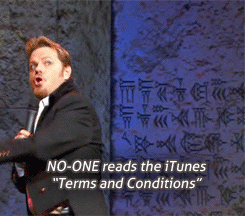Let's Chat About Snapchat
For more than 10 seconds :)

For my blog today, I decided to read the terms and conditions/user policy for the social media app "Snapchat." Now what exactly is the social media app called Snapchat? According to Snapchat's official website:
 |
| "It’s a new kind of camera that’s connected to your friends and the world. Over 180 million people use it every day to talk, play, learn — and take some pictures, too." |
But for my explanation of Snapchat, I would describe it as an app where the user is able to send anyone a picture or video of anything they want another user to see. What makes Snapchat different from other social media apps, is that the user is able to set a time limit for how long the viewer is able to view their image/video. A user is also able to post on their "story" for more than just one person to see, but those are deleted after 24 hours. Basically snapchat is known for nothing being permanent. But because of this, I was curious to see how much control Snapchat has over our ten second images/videos, and since they disappear so quickly, are they really gone forever?
Accessible or Inaccessible
When I went to go read Snapchat's terms and conditions, I had a difficult time finding it. After about 20 seconds looking for where it would be located, I found this tiny symbol in the top right corner of the screen. When comparing this to all of the other features within this app, it was very small and easy to look over. After clicking on this symbol and scrolling almost all the way down to the bottom of the page, I finally found the tab that takes the user to the terms and conditions page. I do not think the terms and conditions are very accessible for users within the app. Which does not make logical sense, because users are only able to use snap by using the actual snapchat application. In order for me to access the terms and conditions page easily, I simply just entered it into google, and was able to display the entire page within 3 seconds. But no normal human being is going to go out of their way on another technology device just to be able to read the terms and conditions on a device they are not able to even access the application on.
 |
| here is an example of the type of photo I would take on snapchat at the age of 12. |
What Surprised Me
After reading the terms and conditions for the app Snapchat, a handful of things stood out to me. One major thing that they listed under "Who Can Use the Services" was that you had to be 13 or older in order to create an account or use this application. This surprised me due to the fact that I know for sure that I was 12 when I created my Snapchat account. I do not quite remember if I lied about the year I was born at the time I made my account or if there was just not an age limit required yet. The next topic under this category that surprised me was that in order to use Snapchat you cannot be a convicted sex offender. I do understand the reasoning behind the sex offenders ineligibility to use Snapchat because inappropriate images and videos can be shared within this application. Which could lead to Stroud and Henson's explanation of revenge porn, in which they explain "A lot of sharing of content and commenting occurs in social media and online, but it is unclear what the consent status of most of this content is." And because people are able to send content for only a couple of seconds, the viewer is able to screenshot the content in which they are able to keep it forever, which was not the senders intent. But it is still surprising to me due to the fact that they insert this regulation into their terms and conditions but do not explain how they enforce this.
Another thing that surprised me personally is that I did not know Snapchat had the rights to use my content whenever they wanted. In their terms and conditions they directly say "You retain whatever ownership rights in that content you had to begin with. But you grant us a license to use that content." I am pretty positive that most users on this application do not know that Snapchat has the right to use any of the content that we users post, and we are basically giving them this right as soon as we create a Snapchat account.
What I Could Not Find
A big theory that a lot of Snapchat users have is if our images/videos actually disappear after they have been viewed for 10 seconds. Or since Snapchat is able to have the right to use our content, does that mean they are able to access any past content that we have sent. Cell phone services are able to access any phone call or text message history whether it was deleted on the actual device or not. Does Snapchat have a method similar to this? This is an important topic that I was hoping to find out when reading the term and conditions, but nowhere within it did they mention anything about it. Although, they have this feature called memories that allows us to see Snapchats that we have saved through-out the years. So it would make sense if they are able to access every Snapchat that we have ever sent, whether we saved it or not.
I personally have never read any terms and conditions pages within my 20 years of life. I never set out to use an application inappropriately because I was taught that whatever I put out onto the internet is permanent, even if you delete it or if your account is private. So I do not read the rules because I kind of expect that I will not do anything that goes against them. The only time I have looked at a terms and conditions page is when I am creating an account on different applications, but all I really do is scroll down to make it look like I read them. I am curious to know why applications make their terms and conditions so long and expect their users to read the whole entire thing. Nobody has that type of patience.
references:
Stroud, Scott R., & Jonathan A. Henson. "Social Media, Online Sharing, & the Ethical Complexity of Consent in Revenge Porn." In The Dark Side of Social Media: A Consumer Psychology Perspective, edited by Angeline Close Scheinbaum, 13-32. New York: Routledge, 2017.
https://www.snap.com/en-US/terms
























